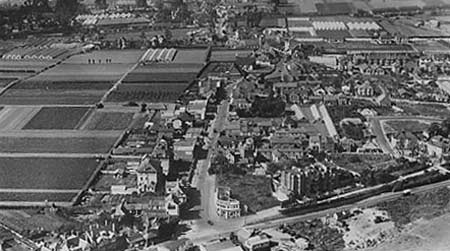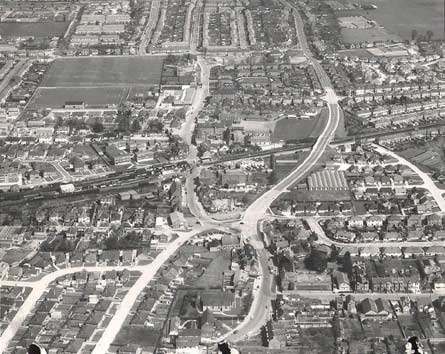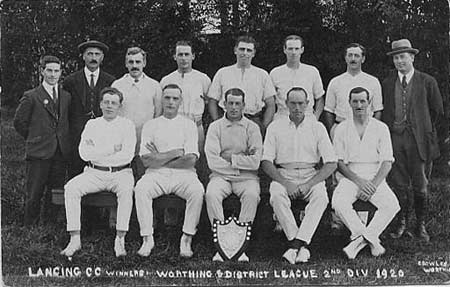|
This article was published in the West Sussex Gazette on March 29th 2001.
Going back to 1900, when high hopes greeted the new century, Britain's Imperial Powers had never been greater. There was, of course, the Boer War, which had started shortly before, but there seemed no doubt that this war would soon be over.
Taking up the story, Mrs Evelyn Farrant (nee Lisher) explains how her family's business came about.
Queen Victoria died in 1901. At this time my father, Frank Lisher, born in 1885 and George, his brother, born two years later in1887, were working for local nurserymen and thus learning the trade. They decided to lease some land in Mash Barn Lane, land that had been bought by a wealthy man who had already built a coach house at the eastern end and walled off a piece of land for a fruit orchard. However, before he had built a proposed large house there, he died.
Father and Uncle George dug all this land by hand (for they didn't own a plough). As they were digging it, they were told it wouldn't be any good as agricultural land for 25 years as at one time the sea had come over the area as far as Grinstead Lane and there was no goodness in the soil. However, with plenty of farmyard manure, it was proved wrong and a good market garden developed.
They saved money, George earning some by emptying sewers, and in 1908 they took on the lease of some land in Elm Grove. Elm Grove had previously been, before the railway, the main road through Cokeham to Worthing. On the land were two greenhouses, a large double-fronted house called 'The Finches' and an adjoining cottage in poor repair. They each paid £200 for the lease. Their parents, George and Emma, moved into the house with them, and they worked the land.

Lancing looking northward from the coastal road c 1930. The nursery of George and Frank Lisher can be seen top left.
|
The land had previously been owned by John Walls, who had used it as a market garden. He had died in 1887 and his wife Hannah in 1891. Son Fred had died in 1885. The lease was with daughter Emily.
The rent was £65 a year. They only drew 2/6d a week each for themselves. The parents, having no rent to pay, kept them. Thus, unmarried, they were able to save enough to buy the house and the adjoining land. It had been agreed as terms in the lease that they could purchase for £2000 within 7 years. In 1911 Frank married and moved to 8 Victoria Terrace, next to his brother Hubert (coal merchant), and when George married he lived at 1 South Street Terrace, South Street.
A valuation of the 'The Finches' in 1912 gave a gross value of £1550 - assessable site value £1000.
George V had become King in 1910. In 1914 war was declared, but this wasn't too hard for the Frank & George business. Both were called up but rejected on health grounds. Frank was told he had enlarged valves in his heart and told to go back and work the land. Their business enlarged as they bought up fields at the southern end of their land. They had prisoners of war working on the land.
Produce was sent by rail to Covent Garden and Brentford Market. My sister, Marjorie, worked in the nursery and did a lot of packing. I remember a shed being built for this purpose.
The business rented a fruit orchard at Cokeham. I can remember going and picking currants and gooseberries. The first Roman Catholic Church, St Paulinus, was built on this land.
It was too good to resist when an offer of £1000 an acre came for the land at Elm Grove. This land was later developed as a housing estate -- Chester Avenue and The Crescent. Fullers' had nursery land adjoining Lishers', and this was also sold.
A new stable was built for the horses but it wasn't long before a mechanical plough was purchased.
George Lisher died in 1942 at the age of 55, from blood poisoning. Penicillin, a new drug then, was used but he proved to be Penicillin-resistant.
By the time the Second World War was on, and George's son, another George (born 1914) and his brother Hubert had also joined the business; George went into the Navy, but ill health prevented Hubert joining up. He was a bad asthmatic. He was away from work a lot and so the main responsibility fell on Frank. He moved back to the house on the land ('The Finches') in 1919.
Frank managed the nursery side of the business, growing tomatoes, mushrooms and chrysanthemums. The number of greenhouses gradually increased as finances allowed until there were 16. I remember the stoke holes where large furnaces burned coke to heat the greenhouses (this later went over to oil burners). My father always took his turn, with other employees, to get up early at weekends to attend to furnaces.

Aerial view of Lancing looking northward, cut in half by the railway running across the picture, with several nurseries visible, c 1960.
|
Young George managed the market garden part of the business. There was a flint-built stable for the two horses and these were used for ploughing during the week but one would be rested on Friday and given a hot mash meal that evening. On Saturday the carter would come down in the evening and take the loaded van to Brighton market. My father, Frank, would travel by train to Brighton where he would lodge the night in a room opposite the market, getting up early on the arrival of the carter, to sell the vegetables and fruit brought for sale.
For a special treat during school holidays I would occasionally be allowed to travel with the carter, meeting my father in the market.
Goods were also sold to local shops, to a Mr. Till, who went around with a horse and trap selling fruit and vegetables, also to a Mr. Hide of Worthing. Chrysanthemums and tomatoes would be boxed, and taken to the railway station on a handcart.
George came safely through the war and back to the business. In 1950 my father decided to retire, selling his share to the brothers. George took over the Mash Barn side of the business, where he erected greenhouses. Hubert took the land of 'The Finches', where he built himself a house, George later building a house in Mash Barn Lane.
As part of the settlement, Frank took over land around his house and fronting on Elm Grove. The original house, taken over when the land was first leased, was demolished in 1929. It was a flint-built house, and I'm sure it would not have been demolished today, but there was trouble with rats. The new house, also called 'The Finches', was erected before the old one was demolished. The cost of building the new house was £1000.
When my father sold out to his nephews the land was valued as agricultural land. An agreement was drawn up that, if the land was sold for building purposes, the difference in value would be allowed to Frank. However, he had died when the land was sold for building. Unfortunately for my sister and I, the solicitor hadn't added 'for his heirs or executors', and no claim could be made.

Lancing Cricket Club photographed with the winner's shield in 1920 when they came top of the 2nd division of the Worthing & District League. George Lisher (born 1887) is the umpire and Frank Lisher (born 1885) is next to him.
|
This article was published in the West Sussex Gazette on March 29th 2001.
| |


